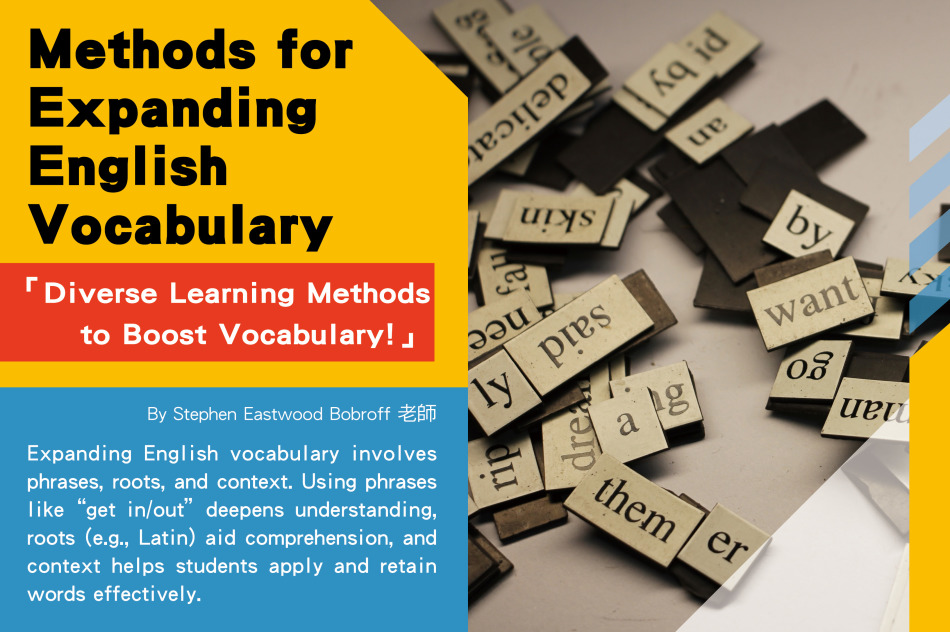
By Stephen Eastwood Bobroff
Phrasal Vocabulary Building:
It’s important for English instructors to demonstrate that patterns exist in English, as in their students’ own languages. English prepositions in particular impose one of the greatest difficulties on English learners, but they can be used to expand vocabulary through the types of phrases they are used in, prepositional phrases (preposition + noun) and phrasal verbs (verb + preposition = new meaning). For instance, the topic of transportation brings many opportunities for teachers to introduce prepositional phrases, as with the phrases “in the car”, “in the truck”, and “in the helicopter”, but “on the bus”, “on the train”, “on the plane”, and “on the boat/ferry”. Staying with transportation, we might build a lesson on phrasal verbs which included terms like “get in/out [of the car/truck/helicopter]”, “get on/off [the bus/train/boat/ferry]”. Focusing on phrases rather than individual words will build students’ vocabulary more efficiently.
Derivational Vocabulary Building:
English is a hybrid language, with strong influences of Greek, Latin, German, and French. Most English words are derived from roots from these languages, and we can highlight one here. In Latin, for example, there is the verb fugere, which translates to English as “flee” or “run away”. Two commonly used English nouns are derived from this: refugee and fugitive. Curiously, native English speakers will likely have a very different opinion about someone described as a refugee from one called a fugitive. A refugee is someone who is trying to escape from a dangerous area, like a warzone, where it is understood that they will be in great danger if they return. A fugitive, on the other hand, is understood as someone who is trying to evade capture by the police, under suspicion of having committed a crime. Students could be invited to label people as either “refugee” or “fugitive” based on series of prepared sample situations. (Students might also learn when a person might be described as both a “refugee” and a “fugitive”, as in the case of someone escaping from a territory under the control of a tyrannical government.) Language teachers need to apprise themselves of the history of the language that they teach so that they can show these linguistic relationships to their students, thereby building the students’ vocabularies. As a start, English teachers should make the most of medical and scientific dictionaries that highlight Greek and Latin roots of English words.
Contextual and Grammatical Vocabulary Building:
Taiwanese students of English often keep notebooks with page after page of hand-written English vocabulary lists with Mandarin translations. Unfortunately, the vocabulary items on these lists too often lack real-life context, with the words on the lists likely being copied from prescribed vocabulary tables for use in standardized test preparation. Of course, in many cases teachers are under great pressure to assist their students in such test prep, but there are better ways. The most difficult and time-consuming lesson that a teacher might prepare is to take such a randomized list of words and fit them into a dialogue, from which students might learn through context. However, there are a few simple tools that can be used to help students learn vocabulary in context.
Large Language Models (LLMs)
(LLMs) can be quickly used to provide situational context to seemingly unrelated vocabulary in dialogues and compositions, but one drawback is that the articles that are produced by such programs often seem forced and robotic to native speakers.
If an instructor would prefer to avoid the use of LLMs, there is a way to impose at least a grammatical context, with a focus on English parts of speech. By having the students create a table, with the titles Noun, Verb, Adjective, and Adverb along the top row, teachers can show how English vocabulary often changes form depending on the part of speech, which is a particularly difficult thing for students whose native language vocabulary requires little or no such change.
An example is the adjective “possible”, which goes with the corresponding noun “possibility” and with the adverb “possibly”. (Note that these words are all derived from the Latin verb posse, which translates to the English phrase “to be able”). These present three different ways to say the same thing, as the following examples show:
1. Adjective: “It is possible that it will rain today.”
2. Noun: “There is a possibility that it will rain today.”
3. Adverb: “It will possibly rain today.”
Regular quizzes can then be used to reaffirm the students’ retention of vocabulary and their ability to adapt words for different grammatical needs.
An example is the adjective “possible”, which goes with the corresponding noun “possibility” and with the adverb “possibly”. (Note that these words are all derived from the Latin verb posse, which translates to the English phrase “to be able”). These present three different ways to say the same thing, as the following examples show:
1. Adjective: “It is possible that it will rain today.”
2. Noun: “There is a possibility that it will rain today.”
3. Adverb: “It will possibly rain today.”
Regular quizzes can then be used to reaffirm the students’ retention of vocabulary and their ability to adapt words for different grammatical needs.
